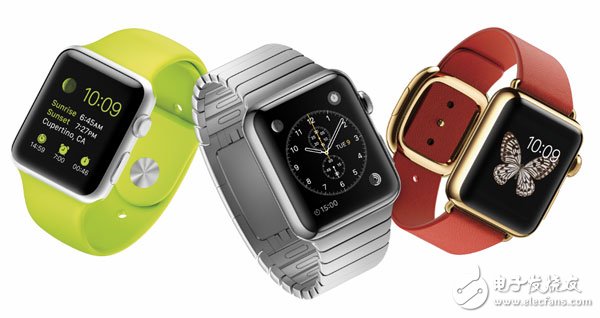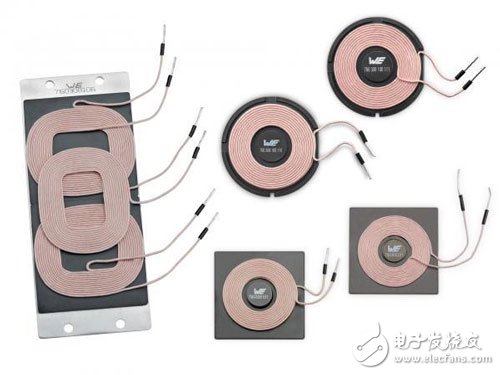
Thin, small, light – these are the basic requirements for wearable devices and explain why the limitations of wearable technology are the length of battery life. Traditionally qualified batteries have lithium battery button batteries, which are sufficient for sensors and other low-power wearable devices, but it is difficult to keep up with the growing number of wearable devices, such as health belts and smart watches. . Most smart watch batteries are now only available for one day. What's more, the eye-catching Apple Watch, which may be released in April, has a battery life of only 2.5 hours.

Figure 1: Apple Watch is Apple's first wearable, revolutionary new technology and groundbreaking user interface. (Photo courtesy of Apple)
For these types of devices, improving battery life is the key to gaining market share, which will be a huge market, with a forecast of 380 million units by 2018. Energy harvesting, wireless charging, battery management, power management and low-consumption solutions are all options for improving battery life in wearable designs. This article will highlight the latest products in these areas to help designers of wearable devices create superior power solutions and better power distribution.
Energy harvesting power management
Energy is absorbed in the body, such as body temperature and limb movement, or energy from the environment, such as ambient light, only microwatts to milliwatts of energy—not enough to support the use of smart watches. Texas Instruments has a device, the bq25570, that pushes the collected 300 to 400 milliwatts to 3 to 5 volts that charge the battery. Although this does not currently generate enough power for a smart watch to work, it can at least extend working hours. "Ultra-low-power, high-energy acquisition management ICs," such as the bq25570, also include a highly efficient nano-power buck converter that provides a second power operating system.
Traditional battery charging (usb or adapter)
We can of course charge the battery of the wearable device in the traditional way, via usb or adapter. TI's new bq25100 single-cell lithium battery charger offers a micro solution that is almost half the size of an existing power solution, while supporting low-cost adapters in a cost-sensitive wearable market. The charger has up to 30V input voltage and 6.5V input voltage protection, among other protection parameters. Maxim's MAX14676/76A provides an alternative to power management for wearable devices. The highly integrated MAX14676/76A, which we can describe as a "wearable power management scheme integrated circuit", includes more than a linear charging circuit, as well as a large amount of low-energy-energy management to save space on the motherboard during extended battery life. These include a 1.8V low quiescent current (lq) 200mA buck regulator, 3.2V low quiescent current 100mA low dropout linear regulator (LDO), 2.0V "always on" 50μA LDO, +5V safety output LDO The 6.6V low Lq120μA charge pump and even the 5V to 17V output boost converters support a wide range of display options.
Both the bq25100 and MAX14676/76A can be paired with a wireless power receiver/transmitter to provide wireless charging capabilities for wearable device designs.
Qi-Compliant wireless charging solution
Wireless charging has become very popular with wearable devices due to its convenience. Compared with the traditional linear charging method, consumers prefer to put the smart watch directly on the wireless charging base instead of looking for the charging cable and socket and connecting the three to charge the smart watch. Therefore, many wireless charging solutions are available for a wide variety of products. The following highlights the Texas Instruments program.
TI offers a cutting-edge design for wireless charging solutions, TIDA-00318, for low-power wearable devices. This solution can be combined with the bq25100 single-cell lithium battery linear charger we introduced earlier, and a Qi compliant wireless power receiver to meet the entire Qi compliant wireless charging solution. Qi is an international interoperability standard for wireless charging devices; any Qi-certified wireless power receiving device, such as the Moto 360 smart watch, can be charged on all bases with Qi certification. Therefore, any wearable device that implements TIDA-00318 should get Qi certification to work on the Qi charging dock. The TIDA-00318 is designed for 135mA charging specifications and is very small, only 5x15mm2.
For a smaller wearable device wireless charging receiver solution, TI has a TIDA-00329 reference design. It only has 5.23mm x 5.48mm combined with your bq51003 Qi compliant wireless power receiver or bq51050B/51B Qi compliant wireless charging. This miniature design can deliver up to 2W of power.
TI provides the TIDA-00334 reference design on a wireless power transmitter, or on the side of a wearable device wireless charging solution charging dock. The bq500212A IC is used in the design of small wearable device transmitters. The power supply for the micro usb connector is 5V. The low power design supports the receiver's output power up to 2.5W.
The TIDA-00334 wireless transmitter reference design is displayed in a 30mm area that matches the diameter of the Wurth coil 760308101103 and is only a little larger than a 15 cent or 2 euro coin.

Figure 2: Wurth Elektronik's WE-WPCC Wireless Charging Receiver Coils meet the WPC's Qi standard.
Power management
Extremely low power conversion is dangerous for the best power life of wearable devices. Here are some of the latest low-power products or high-efficiency DC-DC converters.
TI's TPS727xx series, 250mA LDOs features a very small quiescent current of only 7.9μA, low bleed (100mA typical voltage is 100mV, 200mA typical voltage is 130mV, 250mA typical voltage is 163mV), wide output voltage and load transient response . Another feature of LDO is its high supply-to-voltage rejection ratio (PSRR), a 1kHz 70dB smooth performance in RF applications, and a small, low-cost 10μA ceramic capacitor.
Now TI has introduced the TPS82740B 200mA reduction conversion module, which provides 95% conversion rate, consumes only 360nA lq during operation, and only 70nA when quiet. The small module can be used for full integration, incorporating the switching regulator, inductor and input/output capacitor 9-bump MicroSiPTM components, achieving a size of only 6.7mm2.

Figure 3: Low Power TPS82740x 360nA Micro SIP Reducer Converter Module
Incremental or surge conversions are usually not as efficient as buck conversion. However, increasing the supply voltage is necessary for different circuits in the system, especially for demonstrations. Maxim has a new 1A booster. The MAX8627 enables a single-cell lithium battery to produce a surge in output voltage from 3V to 5V. Up to 95% conversion rate consumes only 20μA lq. The Silicon Valley Lab now has the TS33x turbocharger, with industry-leading lq as low as 150nA. The TS33x increases the input voltage from 0.9V to 3.6V and has eight selectable output voltages ranging from 1.8V to 5V.
Bluetooth, microcontrollers and other low power solutions
In fact, everything in the system needs to be considered when trying to extend the life of a wearable device battery.
A common way to save power is to turn off some power-hungry features, such as processing displays on other things, such as smart watches, tablets, or computers. Bluetooth® Smart, or low-power Bluetooth, is automatically added to most new smartwatches and is therefore the standard for wireless communication for wearable devices. Bluetooth can also be used to transfer information from smartphones to smart watches, and TI offers a “Bluetooth Wearable Watch Development System†called TI Meta WatchTM to ensure the rapid development of related watch devices. The Meta Watch SDK/API makes it easy to receive information from a mobile app or web service on a watch. The development system includes a smart watch with display, and a 3 ATM waterproof stainless steel case, belt watch, ore crystal mirror, vibration motor, three-axis accelerometer, and ambient light sensor.

Figure 4: The Texas Instruments Meta WatchTM Bluetooth® Wearable Watch Development System ensures the rapid development of “Connectable Watches†applications.
The Meta Watch Platform has been optimized for low power operation based on TI's 16-bit MSP430TM ultra-low power microcontroller (MCU) and CC2564 Bluetooth master interface solution.
Choosing an MCU is important for the power management of wearable devices. An efficient MCU can speed up loading data and quickly go to sleep and save power. The low energy sleep mode effectively reduces power consumption when the system is not in use. Designers of wearable devices have more choices of MCUs than before, and 32-bit is more cost-competitive than 16-bit. The ARM's Cortex-M series 32-bit processor core optimized for cost and power sensitive MCUs has foreseen success in the wearable market. From the ultra-low-power Cortex-M0 and M0 to the high-performance Cortex-M7, the ARM Cortex-M series offers a wide range of wearable devices to meet different needs. MCUs based on the ARM-Cortex-M family are now available from many vendors, including Texas Instruments, and STMMicroelectronics, with a huge line of STM32 MCUs, including STM32L1 and L0 ultra-low-power MCUs.
Finally, it is important to consider the power management of countless sensors in wearable devices. The development of sensor technology is fuel that exacerbates the development of the wearable market. But we can't forget the peripheral circuit of the sensor. STMicro can be used in wearable sensors with low-power sensor signal conditioning by providing a QA4NP line set that consumes only 580nA of low-power op amps per channel (at 1.8V supply).
This is just a small part of how low-power management technologies and how products work together to create ultra-low power systems that meet the needs of the wearable market. However, it is important to recognize that ultra-low-power devices are not just enough to wear devices; new low-power technologies can be applied to other applications, programs that have difficulty storing power.
We provide 132kv transmission line and transmission poles.
Our steel poles are made from quality sheet through bending, forming, automatic welding and hot galvanization
We can reach one-run machining length of 14m and can bend sheet of thickness up to 45mm
We adopt advanced welding procedures, automatically weld main joints and reach rank-II welding quality.
Yixing Futao Metal Structural Unit Co. Ltd. is com manded of Jiangsu Futao Group.
Transmission Line Steel Pole,Transmission Line Steel Tubular Pole, 132kv Tranmission Line,Tranmission Poles,Tranmission Line
YIXING FUTAO METAL STRUCTURAL UNIT CO.,LTD( YIXING HONGSHENGYUAN ELECTRIC POWER FACILITIES CO.,LTD.) , https://www.chinasteelpole.com